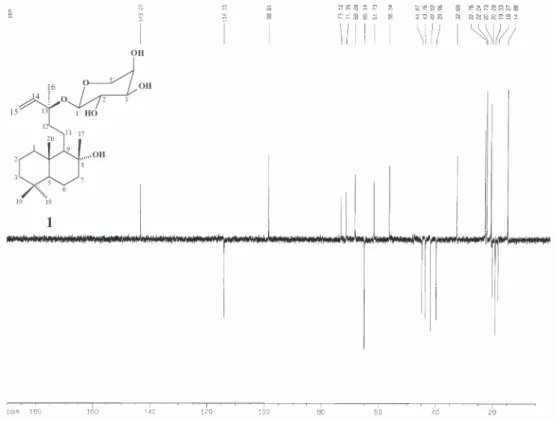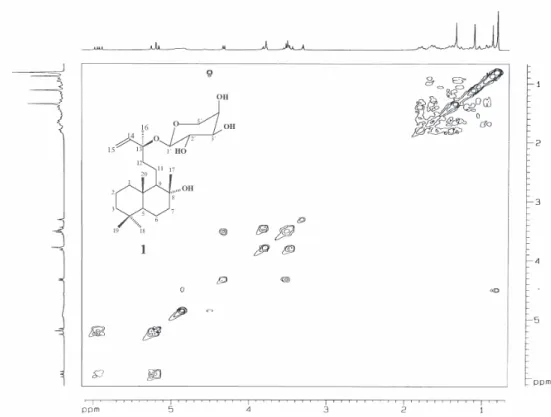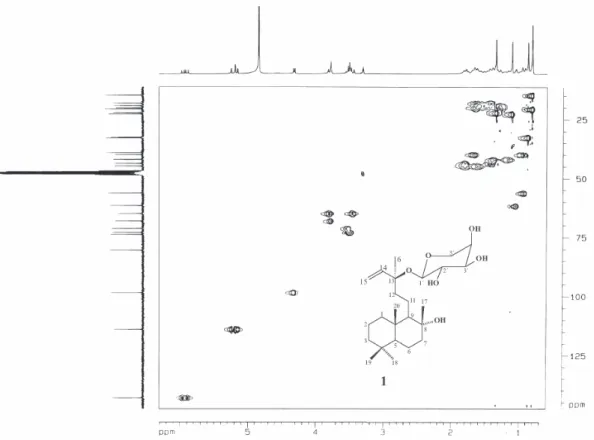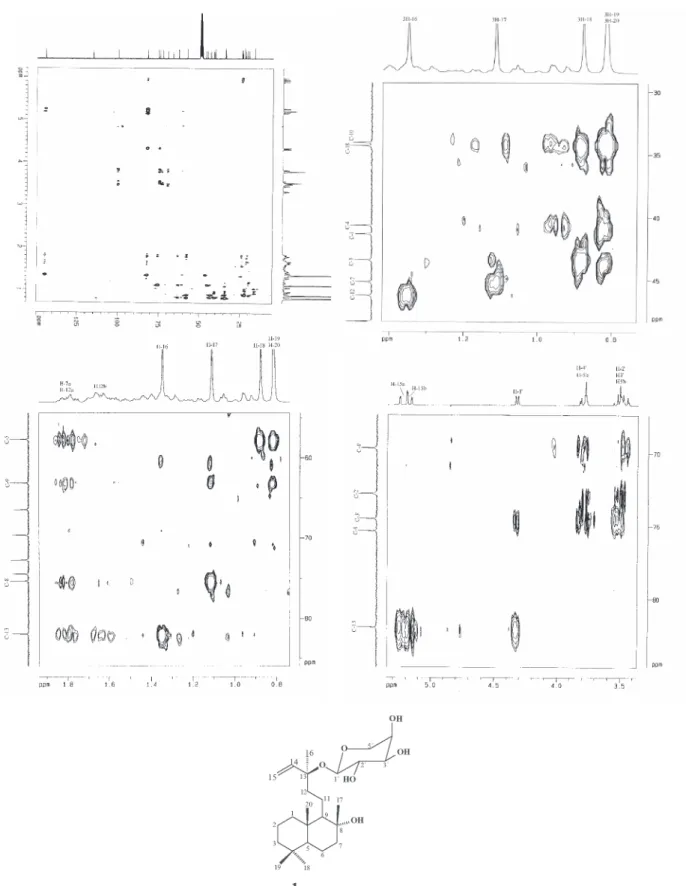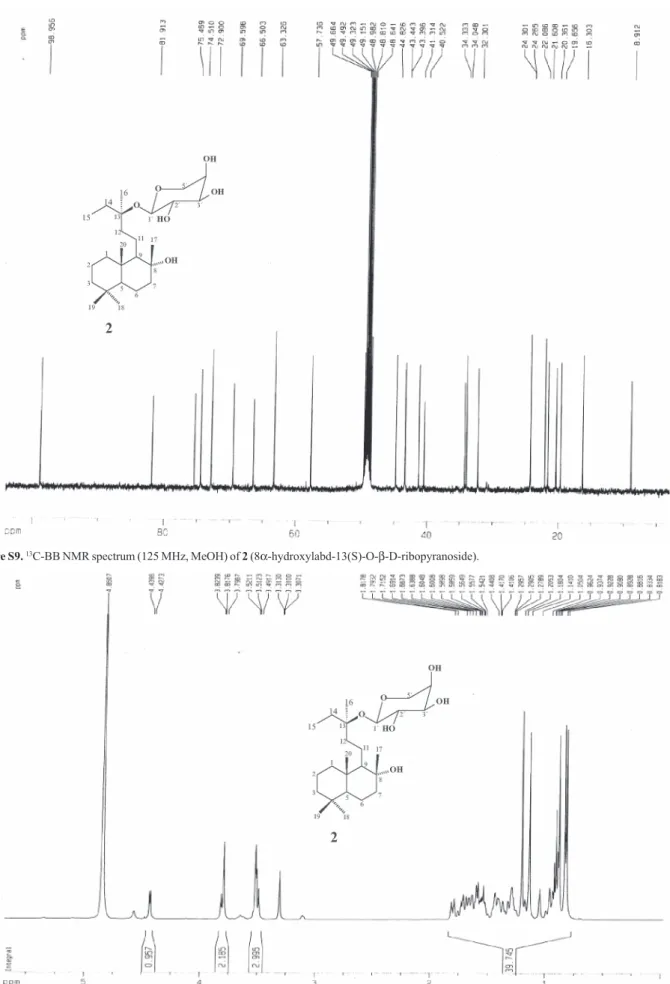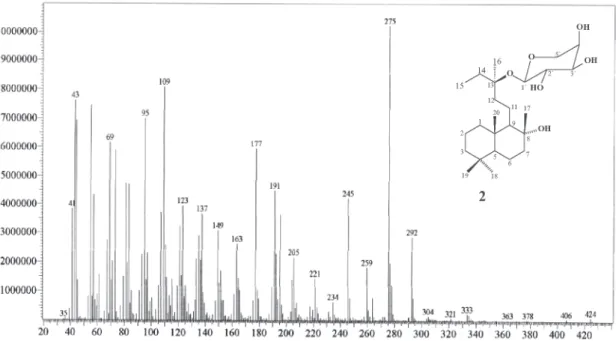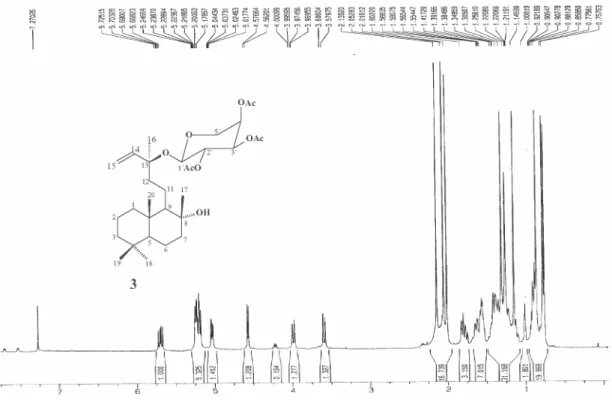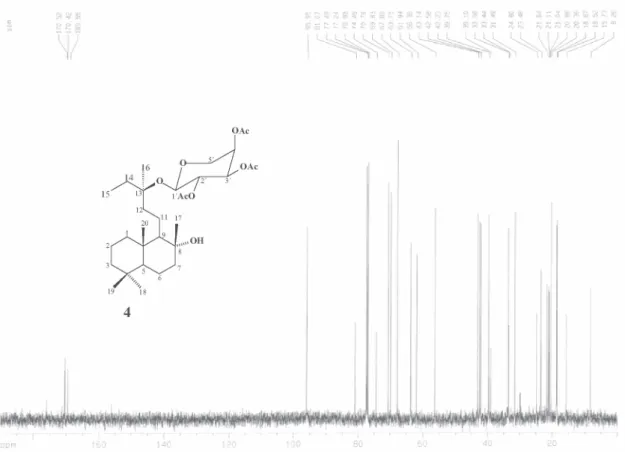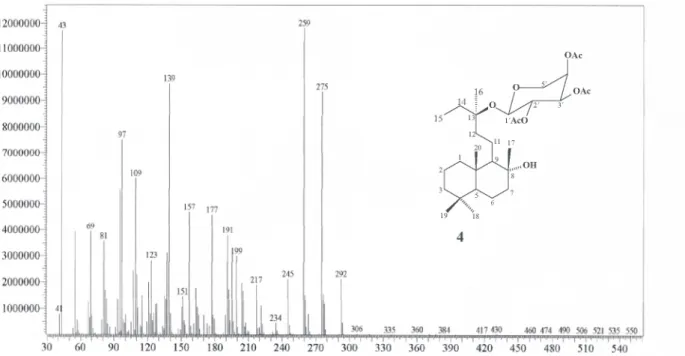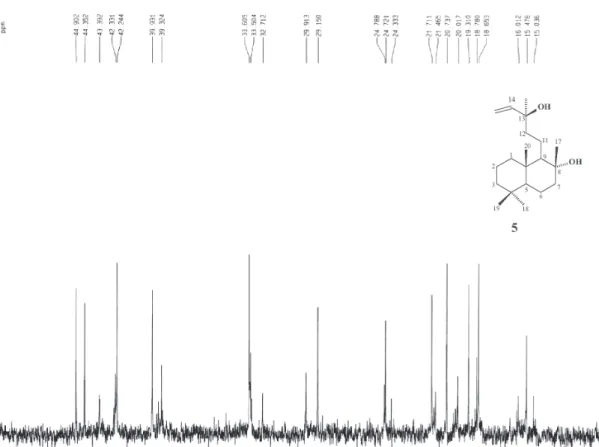J. Braz. Chem. Soc., Vol. 18, No. 7, 1374-1378, 2007. Printed in Brazil - ©2007 Sociedade Brasileira de Química 0103 - 5053 $6.00+0.00
ArticleArticleArticleArticleArticle
*e-mail: mary@dqoi.ufc.br
A Labdane Diterpene from the Aerial Parts of
Egletes viscosa
Less
Francisco Artur e Silva-Filho,a Mary Anne S. Lima,*,a Antonio Marcos E. Bezerra,b Raimundo Braz Filhoc and Edilberto R. Silveiraa
a
Curso de Pós-Graduação em Química Orgânica, Universidade Federal do Ceará, CP 12.200 60.021-940, Fortaleza-CE, Brazil
b
Departamento de Fitotecnia, Universidade Federal do Ceará, CP 12168 60356-760 Fortaleza-CE, Brazil
c
Universidade Estadual do Norte Fluminense, Setor de Química de Produtos Naturais, 28013-600 Campos-RJ, Brazil
Um novo labdano glicosilado, 8α-hidroxilabd-14(15)-eno-13(S)-O-β-D-ribopiranosídeo, foi isolado das partes aéreas de Egletes viscosa Less, juntamente com o 13-epi-esclareol, barbatol, tarapacol, espinasterol, ternatina e triacontano. As estruturas dos compostos isolados foram elucidadas pelo uso de métodos espectrométricos e preparação de derivados químicos.
A new labdane glycoside, 8α-hydroxylabd-14(15)-ene-13(S)-O-β-D-ribopyranoside, was isolated from the aerial parts of Egletes viscosa Less, along with 13-epi-sclareol, barbatol, tarapacol, spinasterol, ternatin and triacontane. The structures of the isolated compounds were elucidated by the use of spectrometric methods and preparation of chemical derivatives.
Keywords: Asteraceae, Egletes viscosa, diterpene glycoside, 8α -hydroxylabd-14(15)-ene-13(S)-O-β-D-ribopyranoside
Introduction
Egletes viscosa Less (Asteraceae) is an annual herb mostly native to intertropical Americas. It is known in the Northeast of Brazil as “macela” or “macela-da-terra” and grows throughout the margins of river and lakes as soon as the raining season ends. The flower buds are largely sold in the herbal stores and used in the folk medicine as emmenagogue, diaphoretic,1 stomachic and
antidiarrhoeal.2
Previous studies with E. viscosa have reported the isolation of biologically active flavonoids and diterpenoids.3-14 Recently, Lee et al reported the isolation
of labdane diterpene glycosides and flavonoids from the entire plant native from Peru.15
In continuation of the work with this species, we report now the isolation of the new labdane glycoside 8α -hydroxylabd-14(15)-ene-13(S)-O-β-D-ribopyranoside 1 in addition to 13-epi-sclareol,16 barbatol,17 tarapacol,18
spinasterol,19 ternatin,7, 20-23 and triacontane from the aerial
parts of E. viscosa. The complete proton and carbon assignments of the known compounds and of the new diterpene 1,including the unpublished 13C and 1H NMR
data of the new derivatives 2-4 were accomplished by the use of a series of 2D NMR experiments such as 1H-1H
COSY, HMQC and HMBC.
Results and Discussion
Compound 1 was isolated as a white solid. Its molecular formula was determined as C25H44O6 from the NMR and EI-mass spectroscopy measurements (m/z = 440). The absorption band in the IR spectrum at 3400 cm-1 was consistent with
hydroxyl groups. Inspection of the 1H NMR spectrum
indicated the presence of three angular methyl groups at δ
0.81 (s, H-19 and H-20) and 0.88 (s, H-18), two methyls attached to oxygenated tertiary carbons at
δ 1.11 (s, H-17) and 1.35 (s, H-16), and an anomeric hydrogen at δ 4.32 (d, J 6.4 Hz, H-1´). Moreover, the presence of a vinyl moiety was suggested by the signals at δ 5.92 (dd, J
17.8, 10.9, H-14); 5.22 (dd, J 17.8, 1.2, H-15a) and 5.17 (dd,
1375 Silva-Filho et al.
Vol. 18, No. 7, 2007
the β-ribopyranosyl unit by the signals at δ 98.6 (C-1´), 73.1 (C-3´), 71.3 (C-2´), 68.2 (C-4´) and 65.1 (C-5´);24 together
with 20 carbon signals ascribable to the aglycone, that were assigned to five methyls, nine methylenes, seven methine and four non-hydrogenated, two of which oxygen bearing carbons (C-13 and C-8).
The unequivocal assignment of NMR spectral data of compound 1 shown in Table 1 was established by data analysis from COSY, HMQC and HMBC experiments. The spectral data attributed to the aglycone unit showed a very similar feature to those described for sclareol.25
The HMBC experiment confirmed the position of glycosylation at C-13 by the correlations of the anomeric hydrogen at δ 4.32 (H-1´) and both methylidene hydrogens at δ 5.22 and 5.17 (H-15a and H-15b) with the oxygenated carbon at δ 80.6 (C-13). The decaline ring system was characterized by long-range correlations of both methyl groups at δ 0.88 (H-18) and 0.81(H-19) with the carbons at δ 42.0 (C-3) and 56.3 (C-5), as well as the methyl groups at δ0.81 (H-20) with the carbons at δ 39.9 (C-1), 56.3 (C-5) and 61.7 (C-9). Further,
pertinent correlations of the methyl group at d 1.11 (H-17) with the carbons at δ 43.7 (C-7), 61.7 (C-9) and 74.0 (C-8) allowed to confirm the allocation of the hydroxyl group at C-8.
A survey in the literature revealed that either (+) or (-) optical rotations can be observed for any kind of sclareol glycosides either from the normal or the enantiomer series, e.g., both the (13R)-labd-14(15)-ene-8,13-diol-13-O-β-fucopyranoside or its aglycone belonging to the normal series show minus signal for their optical rotations,26 but the ent-sclareol [ent
-(13R)-labd-14(15)-ene-8,13-diol] showed (+) signal while its 13-O-β-xylopyranoside derivative showed (-) optical rotation.27 The literature also reports the 13C NMR data
for sclareol,25 ent-sclareol27 and 13-epi-sclareol16. The
latter, obtained from Egletes viscosa of Peruvian origin, showed [α]D20 + 4.5o (c 0.11, CHCl
3).
15
In this work a sclareol entity, 5, was isolated. Comparison of its optical rotation, + 5.0o (c 0.36, CHCl
3),
as well as comparison of the 13C NMR data with those
reported in the literature allowed its identification as
13-Table 1.NMR assignments for the compounds 1-5 (500/125 MHz)
Carbon 1H NMR 13C NMR
1 2 3 4 1 2 3 4 5
1 1.68 1.12 1.69 0.96 0.90 1.56 1.57 0.88 39.9 41.3 39.8 39.7 39.9
2 1.62 1.40 1.66 1.29 1.58 1.62 1.29 20.2 21.6 20.5 20.3 20.7
3 1.40 1.18 1.40 1.18 1.13 1.30 1.39 1.13 42.0 43.3 42.4 42.2 42.2
4 39.3 40.5 39.2 39.1 32.7
5 0.94 (dd, J 11.9, 2.1 Hz) 0.96 (dd, J 11.9, 2.1 Hz) 0.92 (m) 0.90 (m) 56.3 57.7 56.3 56.3 56.2
6 1.58 1.30 1.54 1.27 1.21 1.39 1.58 1.41 19.3 20.3 19.1 18.6 19.3
7 1.82 1.40 1.71 1.54 1.34 1.80 1.79 1.42 43.7 43.4 43.3 42.5 44.9
8 74.0 75.4 74.4 74.4 74.4
9 1.30 1.05 1.00 1.03 61.7 63.3 62.0 61.9 62.0
10 32.9 34.3 33.4 33.4 39.4
11 1.65 1.45 1.63 1.44 1.38 1.56 1.47 1.27 18.2 19.6 18.6 18.5 18.6
12 1.82 1.62 1.81 1.44 1.55 1.75 1.47 1.73 44.8 44.8 45.2 43.1 44.3
13 80.6 81.9 80.9 81.0 75.2
14 5.92 (dd, J 17.8, 10.9 Hz) 1.59 (dd, J 7.5, 2.0 Hz) 5.69 (dd, J 17.2, 10.6 Hz) 1.59 1.38 143.2 32.2 142.1 31.4 145.4 15 5.22 (dd, J 17.8, 1.2 Hz) 0.92 (t, J 7.4 Hz) 5.20 (dd, J 17.8, 1.3 Hz) 0.82 (t, J 7.0 Hz) 114.1 8.9 115.3 8.2 112.0
5.17 (dd, J 10.9, 1.2 Hz) 5.17 (dd, J 10.6, 1.3 Hz)
16 1.35 (s) 1.20 (s) 1.30 (s) 1.13 (s) 22.2 24.2 24.4 23.4 24.7
17 1.11 (s) 1.14 (s) 1.14 (s) 1.16 (s) 22.7 24.3 24.5 24.8 24.3
18 0.88 (s) 0.88 (s) 0.85 (s) 0.85 (s) 32.7 34.0 33.5 33.5 33.6
19 0.81 (s) 0.81 (s) 0.77 (s) 0.76 (s) 20.7 22.0 21.6 21.6 21.7
20 0.81 (s) 0.83 (s) 0.75 (s) 0.77 (s) 14.8 16.3 15.7 15.7 15.4
1´ 4.32 ( d, J 6.4 Hz) 4.42 (d, J 6.4 Hz) 4.56 (d, J 7.3 Hz) 4.62 (d, J 6.5 Hz) 98.6 98.9 96.5 95.9
2´ 3.53 3.52 5.22 5.20 71.3 74.5 69.6 69.8
3´ 3.51 3.51 5.03 5.03 73.1 72.8 70.6 70.7
4´ 3.78 3.79 4.56 5.24 68.2 69.6 67.9 67.8
5´ 3.79 3.98 (dd, J 13.2, 2.5 Hz) 3.60 (d, J 12.5 Hz) 65.1 66.5 63.7 63.7
3.49 3.59 (d, J 13.2 Hz) 3.95 (dd, J 12.5, 2.5 Hz)
1´´ 169.5 169.5
2´´ 2.13 (s) 21.0 21.0
3´´ 170.4 170.4
4´´ 2.01 (s) 20.8 20.8
5´´ 170.6 170.5
1376 A Labdane Diterpene from the Aerial Parts of Egletes viscosa Less J. Braz. Chem. Soc.
epi-sclareol, based mainly on the C-13 chemical shift (δ
75.2), which in the case of sclareol (or ent-sclareol) is found at δ 73.0. (Table 1).16,25,27 Thus, according to the
latter evidences we suggest that the diterpenes here reported belong to the 13-epi-sclareol series whose stereochemistry is depicted in Figure 1.
On the basis of the above spectroscopic data, in addition to all optical rotation considerations, compound
1 was identified as the novel labdane diterpenoid 8
α-hydroxylabd-14(15)-ene-13(S)-O-β-D-ribopyranoside. Chemical derivatization by usual methods was used to confirm the proposed structure and yielded the new labdane derivatives 2-4, to which the 1H and 13C NMR
data are presented in Table 1.
The isolated diterpenes 8α -hydroxylabdan-14(15)-en-13(S)-O-β-D-ribopyranoside 1, barbatol, tarapacol, as well as the derivatives 2-4, were tested for their cytotoxicity using five tumor cell lines: two human leukemias (HL-60 and CEM), human breast adenocarcinoma (MCF-7), human colon adenocarcinoma (HCT-8) and murine melanoma (B16), but none showed any cytotoxic activity.
Experimental
General procedures
Melting points were obtained on a Mettler FP82HT apparatus and are uncorrected. IR spectra were recorded using a Perkin Elmer 1000 FT-IR spectrophotometer. Optical rotations were measured on a Perkin Elmer 341 polarimeter. The mass spectra were obtained on a Hewlett-Packard 5971 mass spectrometer by electron impact ionization (70 eV). 1H and 13C NMR spectra were
recorded on a Bruker Avance DRX-500 (500 MHz for 1H
and 125 MHz for 13C); chemical shifts are given in ppm
relative to residual CHCl3 (7.24 and 77.0 ppm). Silica Gel 60 (Merck, 230-400 mesh) was used for analytical
TLC. Silica gel 60 (Merck, 60 F254, 0.2 mm) was used for column chromatography. All compounds were visualized on TLC by spraying with vanillin/perchloric acid/EtOH followed by heating.
Plant material
Aerial parts of cultivated Egletes viscosa Less were harvested from garden beds at the Departamento de Fitotecnia of the Universidade Federal do Ceará, Fortaleza, Ceará State. Voucher specimens (36694) have been identified by Dr. Edson Paula Nunes and deposited at the Herbário Prisco Bezerra (EAC), Departamento de Biologia, Universidade Federal do Ceará, Fortaleza, CE, Brazil.
Extraction and isolation
Dried aerial parts of E. viscosa (1.35 kg) were pulverized and extracted with hexane at room temperature (3 × 8 L). The solvent was removed under reduced pressure to give the correspondent extract and the mark obtained after hexane extraction was reextracted with EtOH (3 × 8 L).
The hexane extract (12.7 g) was coarsely fractionated on a Silica gel column by elution with hexane, CHCl3, EtOAc and MeOH. Chromatography of the hexane fraction (1.87 g) using hexane/EtOAc mixtures with increasing polarity yielded triacontane (38.7 mg, 0.3 %). Successive flash chromatography of the CHCl3 fraction (3.0 g) using 0-100 % hexane/EtOAc mixtures yielded spinasterol (120.0 mg, 0.94 %) and 13-epi-sclareol 5 (32.0 mg, (0.25 %). The EtOAc fraction (2.0 g) was further purified over Sephadex LH-20 by elution with MeOH to yield tarapacol (8.9 mg, 0.07 %).
The EtOH extract (15.0 g) was redissolved in a mixture of MeOH:H2O (1:1 v/v) and submitted to liquid-liquid partition with petrol ether, CHCl3, EtOAc and MeOH to give four fractions. Chromatography on a Silica gel column of the petrol ether fraction (2.4 g) by elution with hexane, CHCl3, EtOAc and MeOH yielded the correspondent sub-fractions. Flash chromatography of the CHCl3 sub-fraction (590.5 mg) using hexane/ EtOAc mixtures with increasing polarity, afforded 80 fractions. Preparative chromatography of the fraction 68-73 (43.5 mg) by elution with a mixture of CHCl3/ EtOAc 1:1 yielded compound 1 (19.0 mg). TLC preparative chromatography by elution with hexane/ EtOAc (6:4 v/v) of fraction 30-36 (36.0 mg, 0.24 %) yielded barbatol (8.2 mg, 0.05 %). The EtOAc sub-fraction (3.0 g) was further purified over Sephadex LH-20 by elution with MeOH to afford ternatin (6.1 mg, 0.04 %).
1377 Silva-Filho et al.
Vol. 18, No. 7, 2007
Hydrogenation of 1
Compound 1(12.0 mg) dissolved in EtOAc (5.0 mL) was added to a suspension containing Pd/Rh (2.0 mg) in MeOH (10.0 mL), that was previously saturated with H2. The mixture was stirred at room temperature during 30 minutes. Usual work up and SiO2 column chromatography using hexane/CHCl3 2:1 yielded compound 2 (10.0 mg, 83.3 %) as a white solid.
Acetylation of 1
To a solution of compound 1 (5.0 mg) in pyridine (1.0 mL) were added Ac2O (1.0 mL) and a catalytic amount of DMAP. The mixture was stirred for 30 minutes at room temperature. Subsequent workup afforded a residue that was chromatographed using hexane/CHCl3 (3:1) as eluent to yield compound 3 (6.0 mg, 94.0 %) as a yellowish solid.
Hydrogenation of 2
Compound 2(10.0 mg) dissolved in EtOAc (4.0 mL) was added to a suspension containing Pd/Rh (2.0 mg) in MeOH (80.0 mL) that was previously saturated with H2. The mixture was stirred at room temperature during 30 minutes. Usual work up and SiO2 column chromatography using hexane/CHCl3 2:1 yielded compound 4 (8.0 mg, 80.0 %) as a white solid.
8α-hydroxylabd-14(15)-ene-13(S)-O-β-D-ribopyranoside(1)
White solid; m.p. 89.7 – 91.0 oC; [α] D
20: +10.0o (MeOH; c
0.02); IR (film) νmax /cm-1: 3400, 2927, 2867, 1647, 1459, 1388,
1131, 1073, 1002, 918, 784; EIMS m/z (rel. int.): 440 [M+•](3),
290 (8), 273 (15), 257 (6), 245 (3), 232 (2), 217 (8), 203 (13), 191 (59), 177 (75), 163 (25), 149 (14), 137 (14), 123 (20), 109 (39), 95 (58), 81 (79), 69 (44), 43 (100), 41 (71).
8α-hydroxylabd-13(S)-O-β-D-ribopyranoside (2)
White solid; m.p. 71.7 – 74.2 oC; [α] D
20: +7.0o (MeOH;
c 0.28); IR (film) νmax /cm-1: 3400, 2927, 2867, 1647, 1459,
1388, 1131, 1073, 1002, 918, 784; EIMS m/z (rel. int.): 442 [M+•](4), 292 (27), 275 (100), 259 (17), 245 (41), 234
(17), 221 (14), 205 (21), 191 (43), 177 (57), 163 (25), 149 (30), 137 (36), 123 (38), 109 (78), 95 (68), 95 (69), 69 (60), 43 (74), 41 (37).
8α-hydroxylabd-14(15)-ene-13(S)-O-β-D -2´,3´,4´-triacetylribopyranoside(3)
Colorless resin; [α]D20: +15.0o (CHCl
3; c 0.02); IR
(film) νmax/cm-1: 3366, 2925, 2852, 1748, 1493, 1380,
1347, 1131, 1092, 1073, 1002, 944, 823, 702; EIMS
m/z (rel. int.): 566 [M•+](5), 292 (14), 275 (63), 259
(11), 245 (31), 234 (3), 221 (7), 204 (27), 191 (37),
177 (56), 163 (27), 149 (31), 137 (32), 123 (28), 109 (42), 95 (58), 73 (83), 69 (71), 43 (100), 41 (52).
8α-hydroxylabd-13(S)-O-β-D-2´,3´,4´- triacetylribo-pyranoside(4)
Colorless resin; [α]D20: +13.0o (CHCl
3; c 0.02); IR (film)
νmax/cm-1: 3322, 2930, 2823, 1752, 1333, 1147, 1096, 1081,
952, 735; EIMS m/z (rel. int.): 568 [M+•](3), 292 (25), 275
(79), 259 (100), 245 (25), 234 (4), 217 (15), 199 (25), 191 (31), 177 (38), 157 (39), 151 (13), 139 (82), 123 (24), 109 (51), 97 (63), 81 (31), 69 (32), 43 (100), 41 (7).
Determination of Cytotoxicity
All compounds (0.39 to 25 µg/mL) were tested for cytotoxic activity at the Departamento de Fisiologia e Farmacologia of the Universidade Federal do Ceará. Five tumor cell lines were used (National Cancer Institute, Bethesda, MD, USA): B=16 (murine melanoma), HCT-8 (human colon), MCF-7 (human breast), CEM and HL-60 (leukemia) after 72 hours of incubation. Doxorubicin (0.01 to 0.58 µg/mL) was used as a positive control. The general viability of cultured cells was determined by reduction of the yellow dye
3-(4,5-dimethyl-2-thiazolyl)-2,5-diphenyl-2H-tetrazolium bromide (MTT) to a blue formazan product as described by Mosmann.28
Acknowledgments
The authors are grateful to CNPq/CAPES/PRONEX/ FUNCAP/FINEP for the fellowships and financial support.
Supplementary Information
Supplementary data including spectral data of all compounds are available free of charge at http:// jbcs.sbq.org.br, as PDF file.
References
1. Braga, R.; Plantas do Nordeste, especialmente do Ceará, Imprensa Oficial: Fortaleza, Brazil, 1960.
2. Correia, P.; Dicionário de Plantas Úteis do Brasil e das Exóticas Cultivadas, Instituto Brasileiro de Desenvolvimento Florestal: Rio de Janeiro, Brazil, 1984.
3. Souza, M. F; Rao, V. S.; Silveira, E. R.; Braz. J. Med. Biol. Res.
1992, 25, 1029.
4. Souza, M. F.; Cunha, G. M. A.; Fontenele, J. B.; Viana, G. S. B.; Rao, V. S.; Phytother. Res.1994, 8,478.
1378 A Labdane Diterpene from the Aerial Parts of Egletes viscosa Less J. Braz. Chem. Soc.
6. Rao, V. S.; Figueiredo, E. G.; Melo, C. L; Viana, G. S. B.; Menezes, D. B.; Matos, M. S. F.; Silveira, E. R. Pharmacology
1994, 48, 392.
7. Lima, M. A. S.; Silveira, E. R.; Marques, M. S. L.; Santos, R. H. A.; Gambardela, M. T. P.; Phytochemistry 1996, 41, 217. 8. Rao, V. S. N.; Paiva, L. A. F.; Souza, M. F.; Campos, A. R.;
Ribeiro, R. A.; Brito, G. A. C. Souza, M. F.; Rao, V. S. N.; Silveira, E. R.; Phytomedicine1997, 4, 27.
9. Rao, V. S. N.; Santos, F. A.; Sobreira, T. T.; Souza; M. F.; Melo, C. L.; Silveira, E. R.; Planta Med.1997, 63, 146.
10. Souza, M. F.; Rao, V. S. N.; Silveira, E. R; Phytother. Res. 1998, 12, 28.
11. Guedes, M. M.; Cunha, A. N.; Silveira, E. R.; Rao, V. S. N.; Planta Med.2002, 68, 1044.
12. Teixeira, M. J.; Silveira, E. R.; Planta Med.2003, 69, 851. 13. Vieira, G. A. B.; Lima, M. A. S.; Bezerra, A. M.; Silveira, E. R.;
J. Braz. Chem. Soc.2006, 17, 43.
14. Melo, C. M.; Maia, J. L.; Cavalcante, I. J. M.; Lima, M. A. S.; Vieira, G. A. B.; Silveira, E. R.; Rao, V. S. N.; Santos, F. A.; Planta Med.2006, 72, 584.
15. Lee, D.; Li, C.; Graf, T. N.; Vigo, J. S.; Graham, J. G.; Cabieses, F.; Farnsworth, N. R.; Cordell, G. A.; Kinghorn, A. D.; Kroll, D. J.; Wani, M. W.; Oberlies, N. H.; Planta Med. 2005, 71, 792. 16. Stierle, D. B.; Stierle, A. A.; Larsen, R. D.; Phytochemistry1988,
27, 517.
17. Rivero-Cruz, I.; Trejo, J. L.; Aguilar, M. I.; Bye, R.; Mata, R.; Planta Med. 2000, 66, 734.
18. Zhou, L.; Fuentes, R. R.; Hoffmann, J. J.; Timmermann, B. N.; Phytochemistry 1995, 40,1201.
19. Henry, M.; Chatalat-Dublanche, I.; Planta Med. 1995, 4, 322. 20. Vieira, M. M.; Macedo, F. Y. B.; Belarmino Filho, J. N.; Costa, A. C. L. V.; Cunha, A. N.; Silveira, E. R.; Brito, G. A. C.; Ribeiro, R. A.; Phytother. Res. 2004, 18, 135.
21. Pessoa, C.; Silveira, E. R.; Lemos, T. L. G.; Wetmore, L. A.; Moraes, M. O.; Leyva, A.; Phytother. Res.2000, 14, 187. 22. Souza, M. F.; Rao, V. S. N.; Silveira, E. R.; Phytother. Res. 1998,
12, 557.
23. Souza, M. F.; Tome, A. R.; Rao, V. S. N.; Pharm. Pharmacol.
1999, 51, 125.
24. Breitmaier, E.; Voelter, N.; 13C NMR Spectroscopy Methods and
Applications. Verlag Chimie: Düsseldorf, Germany, 1974. 25. Kouzi, S.A.; McChesney, J. D.; J. Nat. Prod. 1991, 54, 483. 26. Lee, S.O.; Choi, S. Z.; Choi, S. U.; Lee, K. C.; Chin, Y. W.; Kim,
J.; Kim, Y. C.; Lee, K. R.; J. Nat. Prod. 2005, 68, 1471. 27. Torrenegra, R.; Robles, J.; Waibel, R.; Lowel, M.; Achenbach,
H.; Phytochemistry 1994, 35, 195.
28. Mosmann, T.; J. Immunol. Methods1983, 16, 55.
J. Braz. Chem. Soc., Vol. 18, No. 7, S1-S19, 2007. Printed in Brazil - ©2007 Sociedade Brasileira de Química 0103 - 5053 $6.00+0.00
Supplementary InformationSupplementary InformationSupplementary InformationSupplementary InformationSupplementary Information
*e-mail: mary@dqoi.ufc.br
A Labdane Diterpene from the Aerial Parts of
Egletes viscosa
Less
Francisco Artur e Silva-Filho,a Mary Anne S. Lima,*,a Antonio Marcos E. Bezerra,b Raimundo Braz Filhoc and Edilberto R. Silveiraa
a
Curso de Pós-Graduação em Química Orgânica, Universidade Federal do Ceará, CP 12.200 60.021-940, Fortaleza-CE, Brazil
b
Departamento de Fitotecnia, Universidade Federal do Ceará, CP 12168 60356-760 Fortaleza-CE, Brazil
c
Universidade Estadual do Norte Fluminense, Setor de Química de Produtos Naturais, 28013-600 Campos-RJ, Brazil
S2 A Labdane Diterpene from the Aerial Parts of Egletes viscosa Less J. Braz. Chem. Soc.
Figure S2. 13C-DEPT 135° NMR spectrum (75 MHz, MeOD) of 1 (8α-hydroxylabd-14(15)-ene-13(S)-O-β-D-ribopyranoside).
S3 Silva-Filho et al.
Vol. 18, No. 7, 2007
Figure S5. NOESY NMR spectrum (300 MHz, MeOD) of 1 (8α-hydroxylabd-14(15)-ene-13(S)-O-β-D-ribopyranoside).
S4 A Labdane Diterpene from the Aerial Parts of Egletes viscosa Less J. Braz. Chem. Soc.
Figure S6. HMQC NMR spectrum (300 MHz, MeOD) of 1 (8α-hydroxylabd-14(15)-ene-13(S)-O-β-D-ribopyranoside).
S5 Silva-Filho et al.
Vol. 18, No. 7, 2007
S6 A Labdane Diterpene from the Aerial Parts of Egletes viscosa Less J. Braz. Chem. Soc.
Figure S9. 13C-BB NMR spectrum (125 MHz, MeOH) of 2 (8α-hydroxylabd-13(S)-O-β-D-ribopyranoside).
S7 Silva-Filho et al.
Vol. 18, No. 7, 2007
Figure S11. HR-EIMS spectrum of 2 (8α-hydroxylabd-13(S)-O-β-D-ribopyranoside).
Figure S12. 13C-BB NMR spectrum (125 MHz, CDCl
S8 A Labdane Diterpene from the Aerial Parts of Egletes viscosa Less J. Braz. Chem. Soc.
Figure S13. 1H NMR spectrum (500 MHz, CDCl
3) of 3 (8α-hydroxylabd-14(15)-ene-13(S)-O-β-D-2´,3´,4´- triacetylribopyranoside).
S9 Silva-Filho et al.
Vol. 18, No. 7, 2007
Figure S15. 13C-BB NMR spectrum (125 MHz,CDCl
3) of 4 (8α-hydroxylabd-13(S)-O-β-D-2´,3´,4´-triacetylribopyranoside).
Figure S16. 1H NMR spectrum (500 MHz, CDCl
S10 A Labdane Diterpene from the Aerial Parts of Egletes viscosa Less J. Braz. Chem. Soc.
Figure S17. HR-EIMS spectrum of 4 (8α-hydroxylabd-13(S)-O-β-D-2´,3´,4´-triacetylribopyranoside).
Figure S18. 13C-BB NMR spectrum (125 MHz,CDCl
S11 Silva-Filho et al.
Vol. 18, No. 7, 2007
Figure S19. 13C-BB NMR expansion spectrum(125 MHz,CDCl
3) of 5 (13-epi-sclareol).
Figure S20. 1H NMR spectrum (500 MHz, CDCl
S12 A Labdane Diterpene from the Aerial Parts of Egletes viscosa Less J. Braz. Chem. Soc.
Figure S21. 1H NMR expansion spectrum (500 MHz, CDCl
3) of 5 (13-epi-sclareol).
S13 Silva-Filho et al.
Vol. 18, No. 7, 2007
Figure S23. 13C-BB NMR spectrum (125 MHz,CDCl
3) of Barbatol.
Figure S24. 1H NMR spectrum (500 MHz, CDCl
S14 A Labdane Diterpene from the Aerial Parts of Egletes viscosa Less J. Braz. Chem. Soc.
Figure S25. HR-EIMS spectrum of Barbatol.
Figure S26. 13C-BB NMR spectrum (125 MHz,CDCl
S15 Silva-Filho et al.
Vol. 18, No. 7, 2007
Figure S27. 1H NMR spectrum (500 MHz, CDCl
3) of Tarapacol.
Figure S28. 13C-BB NMR spectrum (75 MHz,CDCl
S16 A Labdane Diterpene from the Aerial Parts of Egletes viscosa Less J. Braz. Chem. Soc.
Figure S29. 1H NMR spectrum (300 MHz, CDCl
3) of Spinasterol.
S17 Silva-Filho et al.
Vol. 18, No. 7, 2007
Figure S31. 13C-BB NMR spectrum (125 MHz,CDCl
3) of Ternatin.
Figure S32. 1H NMR spectrum (500 MHz, CDCl
S18 A Labdane Diterpene from the Aerial Parts of Egletes viscosa Less J. Braz. Chem. Soc.
Figure S33. HR-EIMS spectrum of Triacontane.
Figure S34. 1H NMR spectrum (500 MHz, CDCl
S19 Silva-Filho et al.
Vol. 18, No. 7, 2007
Figure S35. 13C-BB NMR spectrum (125 MHz,CDCl
